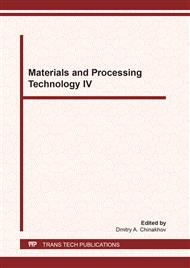[1]
Yu. P. Sharkeev, A. Yu. Eroshenko, Zh. G. Kovalevskaya, A. A. Saprykin, E. A. Ibragimov, I. A. Glukhov, M. A. Chimich, P. V. Uvarkin, E. V. Babakova, Phase Composition and Microstructure of Ti-Nb Alloy Produced by Selective Laser Melting, IOP Conference Series: Materials Science and Engineering, 2016, 140(1), 012020.
DOI: 10.1088/1757-899x/140/1/012020
Google Scholar
[2]
A. A. Saprykin, Yu. P. Sharkeev, E. A. Ibragimov, E. V. Babakova, Zh. G. Kovalevskaya, A. Yu. Eroshenko, M. A. Khimich, P. V. Uvarkin, I. A. Glukhov, Synthesizing conditions and structural-phase state of Ti-Nb alloy when selective laser melting ECCM 2016, Proceeding of the 17th European Conference on Composite Materials, (2016).
DOI: 10.1007/s11182-016-0790-z
Google Scholar
[3]
A. A. Saprykin, N. A. Saprykina, D. V. Dudikhin, S. M. Emelyanenko, Influence of layer-bylayer laser sintering modes on the thickness of sintered layer of cobalt-chromium-molybdenum powder, Advanced Materials Research, 2014, 1040, pp.805-808.
DOI: 10.4028/www.scientific.net/amr.1040.805
Google Scholar
[4]
X. Zhou, K. Li, D. Zhang, X. Liu, J. Ma, W. Liu, Z. Shen, Textures formed in a CoCrMo alloy by selective laser melting, J. Alloys Compd, 2015, 631, pp.153-164.
DOI: 10.1016/j.jallcom.2015.01.096
Google Scholar
[5]
A. Takaichi, Suyalatu, T. Nakamoto, N. Joko, N. Nomura, Y. Tsutsumi, S. Migita, H. Doi, S. Kurosu, A. Chiba, N. Wakabayashi, Y. Igarashi, T. Hanawa, Microstructures and mechanical properties of Co-29Cr-6Mo alloy fabricated by selective laser melting process for dental applications, J. Mech. Behav. Biomed. Mater., 2013, 21, pp.67-76.
DOI: 10.1016/j.jmbbm.2013.01.021
Google Scholar
[6]
M. Zhang, Y. Yang, C. Song, Y. Bai, Z. Xiao, An investigation into the aging behavior of CoCrMo alloys fabricated by selective laser melting, J. Alloys Compd., 2018, 750, 878–886.
DOI: 10.1016/j.jallcom.2018.04.054
Google Scholar
[7]
Y. Lu, L. Ren, X. Xu, Y. Yang, S. Wu, J. Luo, M. Yang, L. Liu, D. Zhuang, K. Yang, J. Lin, Effect of Cu on microstructure, mechanical properties, corrosion resistance and cytotoxicity of CoCrW alloy fabricated by selective laser melting, J. Mech. Behav. Biomed. Mater., 2018, 81, pp.130-141.
DOI: 10.1016/j.jmbbm.2018.02.026
Google Scholar
[8]
L. Ren, K. Memarzadeh, S. Zhang, Z. Sun, C. Yang, G. Ren, R.P. Allaker, K. Yang, A novel coping metal material CoCrCu alloy fabricated by selective laser melting with antimicrobial and antibiofilm properties, Mater. Sci. Eng., 2016, 67, pp.461-467.
DOI: 10.1016/j.msec.2016.05.069
Google Scholar
[9]
E. Zhang, C. Liu, A new antibacterial Co-Cr-Mo-Cu alloy: Preparation, biocorrosion, mechanical and antibacterial property, Mater. Sci. Eng., 2016, 69, pp.134-143.
DOI: 10.1016/j.msec.2016.05.028
Google Scholar
[10]
G. Barucca, E. Santecchia, G. Majni, E. Girardin, E. Bassoli, L. Denti, A. Gatto, L. Iuliano, T. Moskalewicz, P. Mengucci, Structural characterization of biomedical Co-Cr-Mo components produced by direct metal laser sintering, Mater. Sci. Eng., 2015, 48, pp.263-269.
DOI: 10.1016/j.msec.2014.12.009
Google Scholar
[11]
A. P. Nazarov, Development of the technological process for manufacturing complex-profile parts and heat-resistant cobalt alloy by selective laser melting: dis. candidate of technical Sciences, Moscow, (2013).
Google Scholar
[12]
M. W. Benjamin, W. B. Scott, A. G. Russell, G. C. Linda, M. S. Emanuel, J. C. Michael, Solid free-form fabrication of drug delivery devices, Journal of Controlled Release, 1996, 40, 1–2, pp.77-87.
Google Scholar
[13]
I. V. Shishkovsky, Selective laser sintering and synthesis of functional structures: dis. Samara, 2005, 390.
Google Scholar
[14]
I. I. Zhuravleva, T. V. Rodchenko, A. L. Petrov, V. I. Shcherbakov, A. I. Snarev, I. V. Shishkovsky, Modeling and studying the properties of gradient filtering elements using the synthesized SLS method, Laser engineering and technology, 2006, pp.419-428.
Google Scholar
[15]
I. V. Shishkovskii, I. A. Yadroitsev, I. Yu. Smurov, Selective laser sintering/melting of nitinol– hydroxyapatite composite for medical applications, Powder Metallurgy and Metal Ceramics September, 2011, 50, 5-6, pp.275-283.
DOI: 10.1007/s11106-011-9329-6
Google Scholar
[16]
A. P. Nazarov, A. A. Okunkova, Typical samples of products obtained by selective laser sintering, Bulletin of the Saratov state technical University, 1 (67), 3, 2012, pp.76-82.
Google Scholar
[17]
http://liat-stankin.ru.
Google Scholar
[18]
M. PodrezRadziszewska, K. Haimann, W. Dudziński, M. Morawska-Sołtysik, Characteristic of intermetallic phases in cast dental CoCrMo alloy, Archives of foundry engineering, 10, 3, 2010, pp.51-56.
Google Scholar
[19]
C. Suryanarayana, Mechanical alloying and Milling, Progress in Materials Science, 2001, vol. 46, pp.1-184.
Google Scholar
[20]
T. F. Grigorieva, A. P. Barinova, N. Z. Lyakhov, Mechanochemical synthesis in metal systems: monograph, Novosibirsk, Parallel, 2008, 309.
Google Scholar
[21]
A.J. Saldivar-Garcia, H.F. Lopez, Temperature effects on the lattice constants and crystal structure of a Co-27Cr-5Mo low-carbon alloy, Metallurgical and materials transactions, 2004, pp.2517-2523.
DOI: 10.1007/s11661-006-0232-6
Google Scholar
[22]
https://dpva.ru/Guide/GuidePhysics/Length/AtomicRadius/.
Google Scholar
[23]
H.F. Ping Huang, Lopez Strain induced ε-martensite in a Co–Cr–Mo alloy: grain size effects, Materials Letters, 39, 1999, pp.244-248.
DOI: 10.1016/s0167-577x(99)00021-x
Google Scholar


